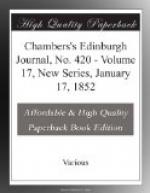During a lengthened residence in Prague, we have had much satisfaction in visiting the establishment of the Sisters, and inquiring into their doings. The house, which was founded in the seventeenth century, and contains seventy inmates, is situated near to the palace of Prince Lobkowitz, in the Kleine Seite, or that part of the city which lies on the right bank of the Moldau. It has much the character of a suburban villa, being surrounded by a kind of plaisance, enclosed in high walls, and containing shrubberies, alleys, and large clumps of chestnuts. In this pleasant retreat may often be found such of the Sisters as are not engaged in the more pressing kind of duties—never quite idle, however; for, even while seeking recreation, they will be found busied in preparing clothing for the poor, or perhaps in making medicines from herbs, if not imparting instruction to children let loose from the school which forms a part of their establishment. The place is remarkable for its perfumes, there being assembled here not merely the usual amount of roses, lilacs, jasmines, tuberoses, and lilies, but a profusion of aromatic plants, cultivated either for medicinal purposes, or to serve in the fabrication of essences and powders, which the Sisters distribute over the world in tiny bottles and small pillow-cases and bags, in order to raise funds for the poor.
In the house, which, having been erected for a private family, is not well suited for its present purpose, everything is an example of cleanliness and order. The hospital is in the main part of the building, and is fitted up with every possible convenience. A large apothecaries’ hall is attached to it, furnished with every appliance that medical art has devised, and under the superintendence of a highly-educated professional man. It is most affecting to enter the great sick-room, and see the gentle Sisters in their modest attire ministering to the patients, bending over them with their sweet and cheerful countenances, as if they felt that relief from pain and restoration to life and its enjoyments depended on their smiles. It is scarcely necessary to say, that the hospital is almost always full. Sometimes, indeed, the floor is occupied with extra beds; for the Sisters will never close their doors to any who apply, even though they should have to abandon their own simple places of repose to the new-comer, and stretch themselves on the bare floor.
We observed, in one of our visits, an old woman who was lying in one of the beds of the hospital, in a kind of trance, neither sleeping nor waking, apparently suffering no pain, but quite insensible to everything which passed around her. Her complaint was that of extreme old age, mere physical exhaustion. She had been for many years a pensioner, fed and clothed by the Sisters: having outlived all her relations, and having no friends in the world but them, she had come in, as she said herself, ‘to die in peace among them.’ Not far from her lay a girl,




